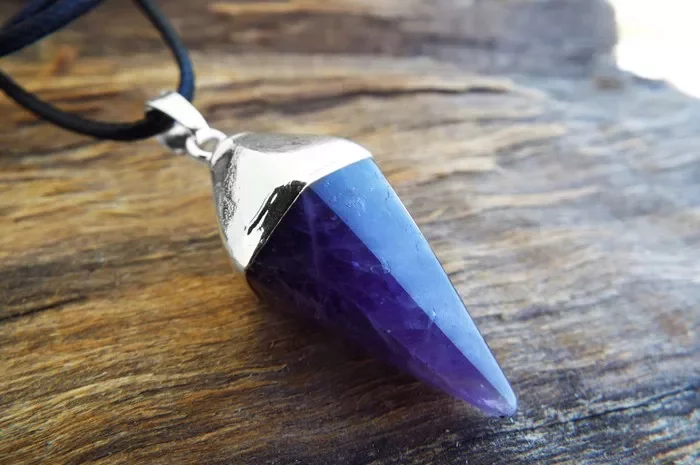The wearing of gemstone jewelry, including amethyst necklaces, in daily activities such as showering has been a subject of debate among jewelry enthusiasts and professionals. While some people argue that wearing gemstone jewelry in the shower is perfectly fine, others believe it to be a taboo due to potential risks associated with water exposure and other shower-related factors. To understand whether wearing an amethyst necklace in the shower is feasible or a taboo, it is crucial to delve into the specific properties of amethyst, the effects of water on gemstones, and the best practices for maintaining gemstone jewelry.
Understanding Amethyst: A Beautiful and Mysterious Gemstone
Amethyst is a variety of quartz that displays a striking purple color, ranging from light lavender to deep violet. This coloration is caused by natural trace elements such as iron and aluminum within the quartz crystal structure. Amethyst has been revered for its beauty and mystical properties throughout history, making it a popular choice for jewelry, particularly necklaces.
Properties of Amethyst and Its Susceptibility to Water
Hardness and Durability:
Amethyst has a hardness rating of 7 on the Mohs scale of mineral hardness, which makes it relatively durable and scratch-resistant. However, it is still softer than some other gemstones like diamonds (hardness of 10) and sapphires (hardness of 9).
Despite its hardness, amethyst can be susceptible to chipping or cracking if subjected to sudden impacts or rough handling.
Water Absorption and Reactivity:
Like many gemstones, amethyst is not inherently water-absorbent. However, prolonged exposure to water, especially hot water, can cause subtle changes in its appearance over time.
The natural porosity of some gemstones can allow water to seep in, potentially leading to discoloration or weakening of the stone’s internal structure. While amethyst is generally less porous than some other gemstones, it is still prudent to be cautious.
Chemical Sensitivity:
Amethyst can react with certain chemicals, such as acids, bases, and cleaning agents commonly found in shower products. These chemicals can etch the surface of the gemstone, causing dullness or loss of shine.
Even mild soaps and shampoos can leave a residue on the gemstone’s surface, which can build up over time and affect its appearance.
The Effects of Showering on Amethyst Necklaces
Temperature Changes:
The rapid change in temperature between hot shower water and the cooler air outside the shower can cause thermal stress on the gemstone and its setting. Over time, this stress can lead to cracks or fractures in the amethyst.
Additionally, sudden temperature changes can cause metals, such as silver or gold, used in the necklace’s setting to expand or contract, potentially weakening the prongs or settings that hold the gemstone in place.
Physical Impact and Wear and Tear:
Showering involves physical movements, such as rubbing the necklace against the skin, hair, and shower walls, which can scratch or dull the gemstone’s surface.
The soap bubbles and water droplets can act as abrasives, further exacerbating wear and tear on the gemstone and its setting.
Exposure to Cleaning Products:
As mentioned earlier, shower products contain a variety of chemicals that can damage gemstones. Even if the necklace is not directly submerged in water, the chemicals in shower gels, shampoos, and conditioners can still come into contact with the gemstone, potentially causing harm.
Best Practices for Wearing Amethyst Necklaces
Given the potential risks associated with wearing an amethyst necklace in the shower, it is generally advisable to follow best practices to ensure the longevity and beauty of the gemstone.
Removing the Necklace Before Showering:
The simplest and most effective way to protect your amethyst necklace is to remove it before showering. This prevents direct exposure to water, temperature changes, and shower chemicals, thereby minimizing the risk of damage.
Storing the Necklace Properly:
When not wearing the necklace, store it in a soft cloth or jewelry box to prevent scratches and protect its surface. Avoid storing it in direct sunlight or in areas with high humidity, as these conditions can fade the gemstone’s color over time.
Regular Cleaning and Maintenance:
To keep your amethyst necklace looking its best, clean it regularly using a soft cloth and warm water. Avoid using harsh chemicals or abrasive cleaners, as these can damage the gemstone’s surface.
If the necklace becomes soiled or stained, consult a professional jeweler for cleaning advice or services.
Inspecting the Necklace Regularly:
Regularly inspect the necklace for signs of wear, such as loose prongs or scratches on the gemstone. If any damage is noted, take the necklace to a professional jeweler for repair or maintenance.
Conclusion
While wearing an amethyst necklace in the shower may seem convenient, it is generally not advisable due to the potential risks associated with water exposure, temperature changes, and shower chemicals. By following best practices, such as removing the necklace before showering, storing it properly, and regularly cleaning and inspecting it, you can ensure that your amethyst necklace remains beautiful and in good condition for many years to come. Remember, the beauty and value of gemstone jewelry lie not only in its appearance but also in the care and maintenance that goes into preserving it.
Related topic:
Can Pink Amethyst Go in Water?


